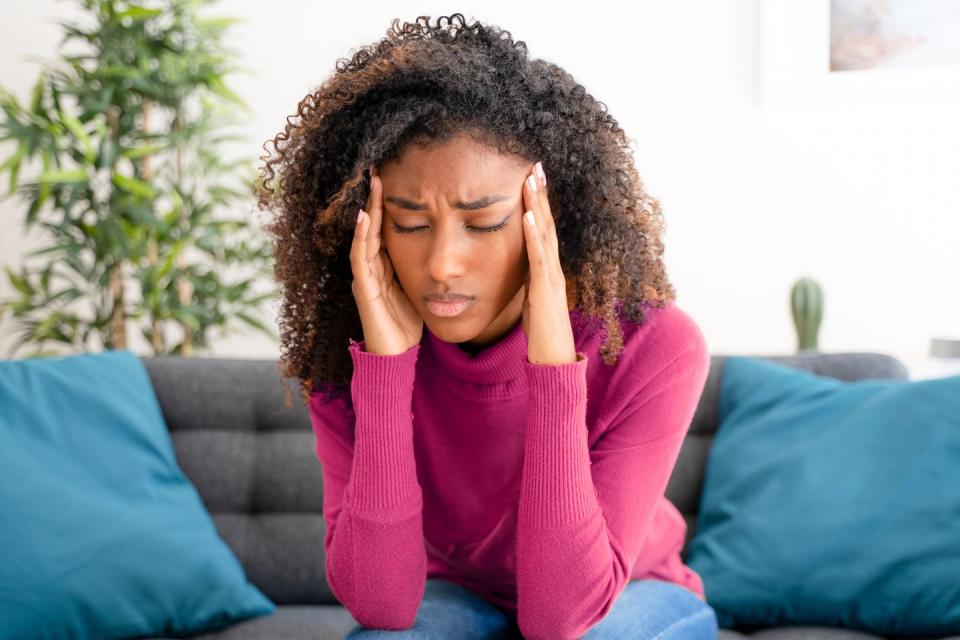5 Different Types of Headaches — And How to Ease the Ouch

Most of us know the throbbing, pounding pain of the occasional headache — and for some people, those "OMG, this hurts" moments come often enough, and intensely enough, to knock them off the path of their everyday lives. Not all headaches are the same, though; there are different types with different causes, and it's empowering to know this information, as well as how to treat the pain and maybe even prevent the next head-pounder from happening.
With the help of neurologist and headache specialist Lauren Natbony, MD, assistant clinical professor of neurology at the Icahn School of Medicine at Mount Sinai and associate director at North Shore Headache and Spine in Huntington, NY., we're bringing you information on these five common types of headaches:
Cluster headache
Chronic migraine
"Sinus" headache
Tension headache
Read on for details about each of these types of headaches, ways to ease the pain, and how to possibly prevent them in the future.
Consult your physician right away if you're experiencing extreme head pain, lose vision or consciousness or have uncontrollable vomiting. You should seek immediate medical attention if you've suffered a head injury.
Cluster Headache
"Cluster headaches are rare and extremely painful," says Dr. Natbony. "Patients describe them as excruciating, with one-sided pain around the eye that may be accompanied by a teary or red eye, nasal congestion or runny nose on one side, plus a swollen or drooping eyelid. The pain is so severe that it usually causes restlessness during an attack, with the need to walk around or pace. Attacks commonly strike about two to three hours after falling asleep and last about 15 minutes to 3 hours. They also tend to be seasonal." Cluster headaches, like the name implies, typically occur in clusters and can be present for weeks and then disappear. "Some people have attacks many times in a year, and for others it can be years between attacks."
Treatment:"Given the acute onset and severity of cluster attacks, natural therapies are usually not effective. First line treatments include high flow oxygen through a non-rebreathing mask and injectable sumatriptan. Both act quickly to stop pain," says Dr. Natbony. A headache doctor can help with those treatments.
Prevention plan: Cluster attacks come in cycles and may not be predictable or preventable, explains Dr. Natbony. "The options for preventive treatment are determined largely by the length of the cluster cycle," she says. "Galcanezumab, verapamil and topiramate are some of the preventative treatments available. Additionally, we know that smoking cigarettes can cause more severe and frequent cluster attacks so quitting can be a good preventative strategy. Alcohol is also a common trigger, so it is best to avoid drinking, especially when in the midst of a cluster cycle."
Migraine
About 12% of people get these head-pounders — three times as many women as men. "Migraine is a debilitating disorder with attacks lasting from 4 to 72 hours, usually located on one side of the head, associated with moderate to severe pain intensity," says Dr. Natbony. "They're often made worse with activity, and can come with with nausea, vomiting, and sensitivity to light and/or sound. Attacks cause throbbing pain, often accompanied by blurred vision, light sensitivity and nausea."
Treatment: Dr. Natbony suggests the following to ease a migraine: "Try turning off the lights and minimizing sounds. Use a hot or cold compress on your neck or head to ease pain. A caffeinated beverage may help, as caffeine, in small amounts, can be a potent pain reliever. If needed, take an OTC pain reliever such as ibuprofen or naproxen. They work best when taken early in a migraine attack."
Prevention plan: The first step is to make changes to your lifestyle, explains Dr. Natbony. "These include getting regular sleep, hydrating with at least 64oz of water per day, eating a protein filled meal or snack every 3 to 4 hours, and getting cardiovascular exercise for 30 to 45 minutes, four or five days each week. When lifestyle changes aren't enough, vitamin supplements, prescription medications, medical devices and complementary treatments such as acupuncture and biofeedback can help to decrease migraine frequency and severity."

Chronic Migraine
Chronic migraine usually evolves from episodic migraine, says Dr. Natbony. "It's diagnosed when headaches are present at least 15 days per month for more than 3 months, with 8 or more days of those severe."
Treatment: "Acute treatment is similar to that for episodic migraine," explains Dr. Natbony. "However, limiting the use of acute medication is important to try to avoid medication overuse and the risk of medication-overuse headache."
Prevention plan: "Daily medications used for episodic migraine can be helpful for chronic migraine," says Dr. Natbony. If they don’t work, she adds, "then Botox and CGRP Monoclonal antibody injections can be good next steps, as both are FDA-approved for chronic migraine prevention."
"Sinus" Headache
There's confusion out there about whether or not sinus headaches are actually a thing. "True sinus headaches are quite rare and are usually caused by viral or bacterial infection," says Dr. Natbony. "Signs of infection include fever and thick, infectious-looking mucous draining from the nose. Overall, most 'sinus' headaches are actually migraine, as the nerves for migraine run through the sinuses and cause pain in the forehead and cheeks."
Treatment: Dr. Natbony has suggestions: "If you think you have a sinus headache, try a nasal rinse or a hot steamy shower to loosen up the secretions. A nasal decongestant can also help, as can acetaminophen or an NSAID. If pain does not improve, then you may in fact be dealing with migraine, and trying treatments recommended for migraine may be helpful."
Prevention plan: If “sinus” headaches are occurring frequently, says Dr. Natbony, "then it's best to speak with your doctor as you may be suffering from migraine and require more targeted therapies."
Tension Headache
"Tension-type headache is usually on both sides of the head, with a pressing or tightening sensation," says Dr. Natbony. "These headaches are mild to moderate in severity, don't get worse with activity, and aren't usually associated with light or sound sensitivity. Usually, there's no nausea or vomiting. Attacks can hang around for anywhere from 30 minutes to seven days. Stress is the most common triggering factor for tension-type headache, and patients often report a link between stressful days and headache occurrences."
Treatment: Similar to migraine, an ice or heat pack can help relieve pain. Try an NSAID such as naproxen or ibuprofen, suggests Dr. Natbony, who also says that exercise, stretching and massaging tight neck muscles can help ease pain as well.
Prevention plan: Dr. Natbony points out, "Stress can be very difficult to manage. Although it’s impossible to remove it from daily life, there are productive ways to deal with it. Exercise can be a great way to manage stress, so aim for 30 minutes most days. Just walking and getting outside can be a good start. And there's evidence that relaxation techniques such as yoga, meditation and progressive muscle relaxation can help."
You Might Also Like


